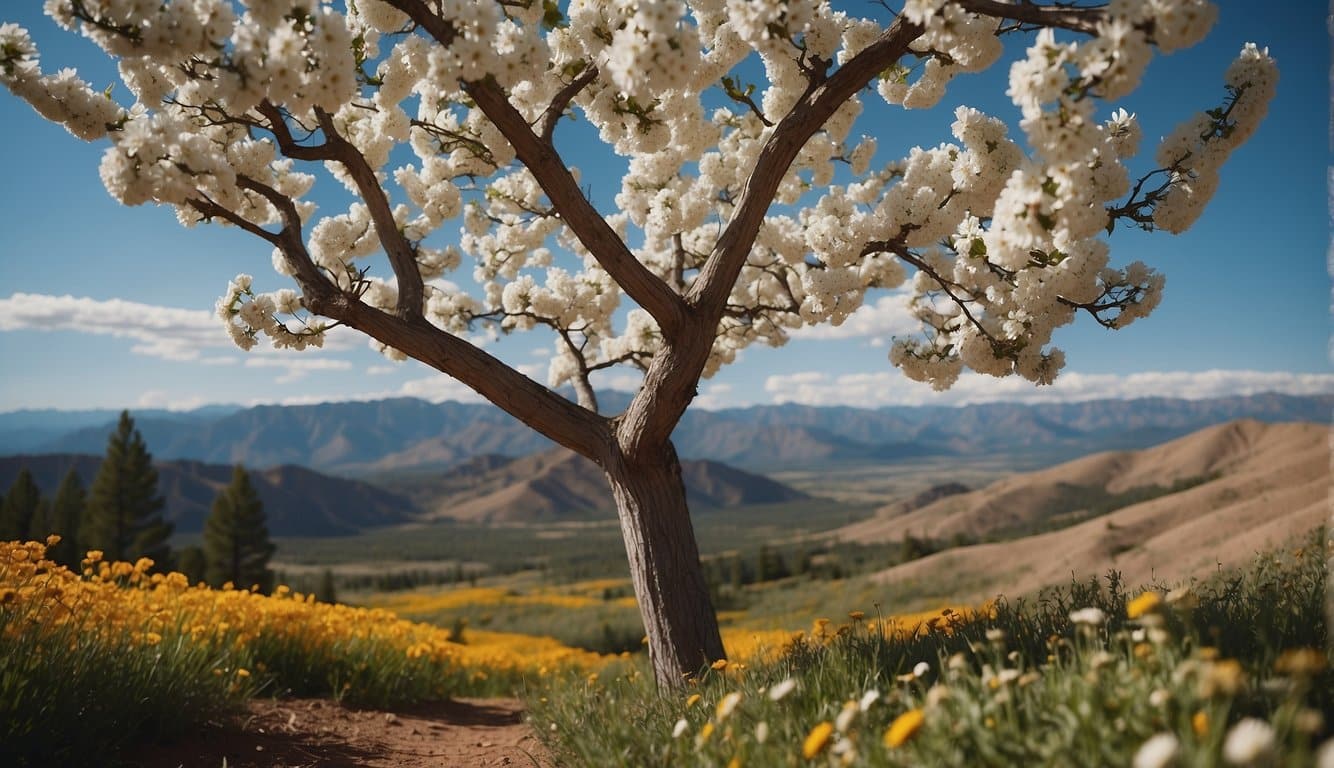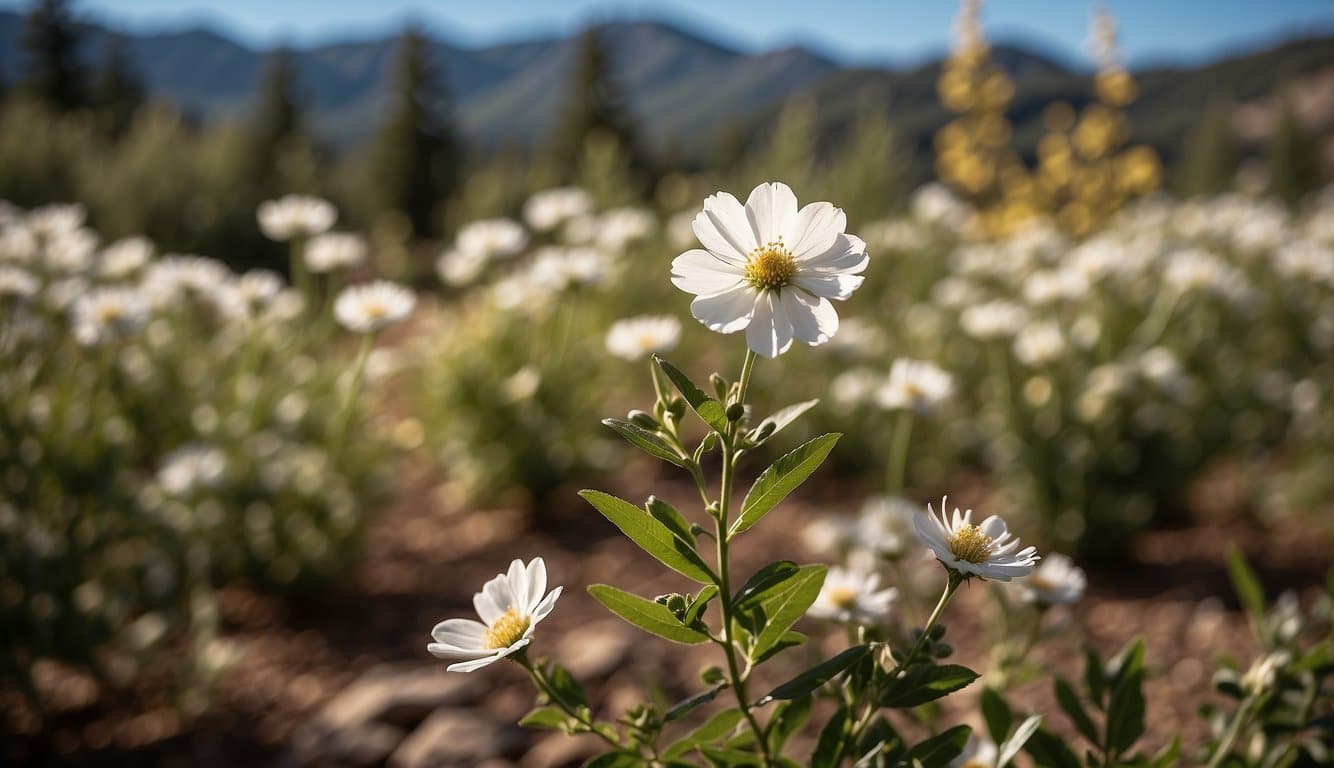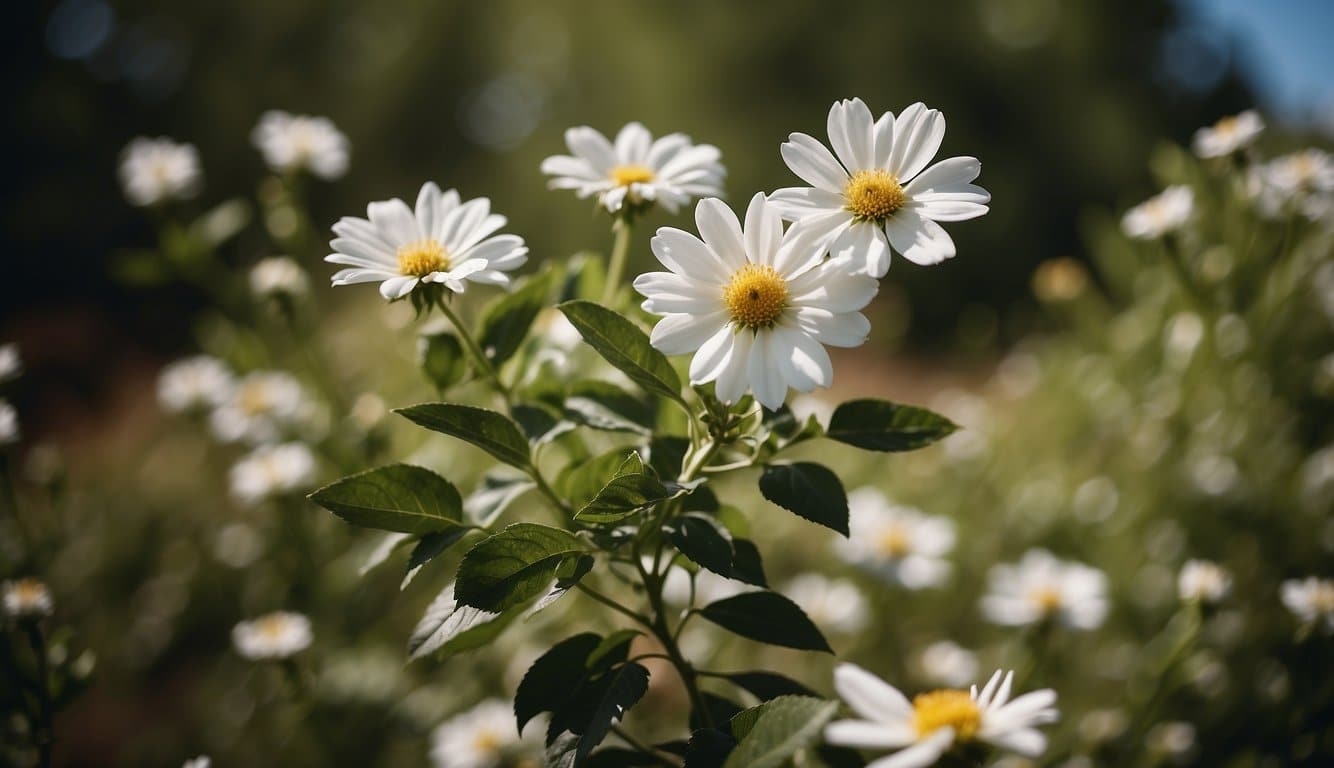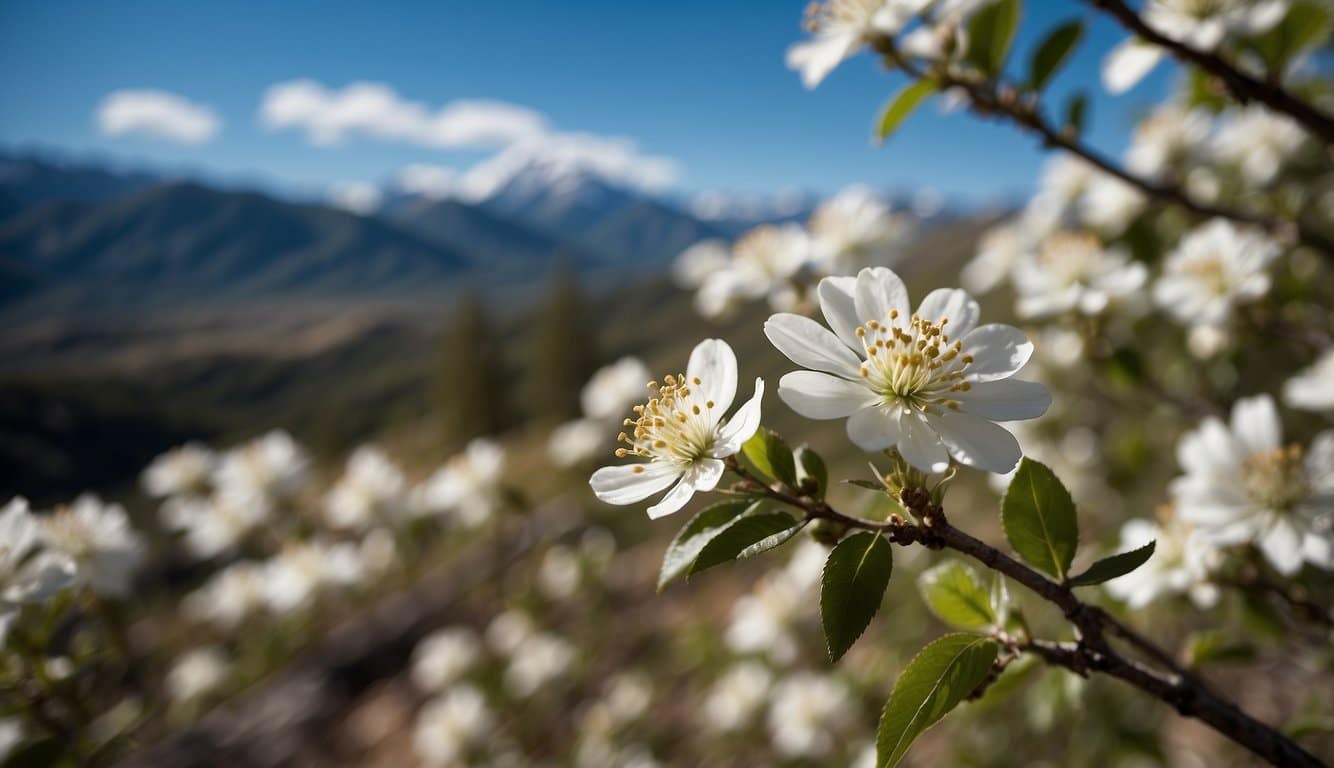Colorado’s diverse landscape offers a stunning backdrop for white flowering trees that add a touch of tranquility and brightness to gardens throughout the state.
Among the splendid variety, the Russian Hawthorn stands tall, gracing the Rockies with its hardy nature and white blossoms. Adapted to the fickle climate, this drought-tolerant species represents the resilience and beauty of Colorado’s flora.
Gardeners in areas prone to dry spells, such as Denver, appreciate these trees for their ability to thrive with minimal water.
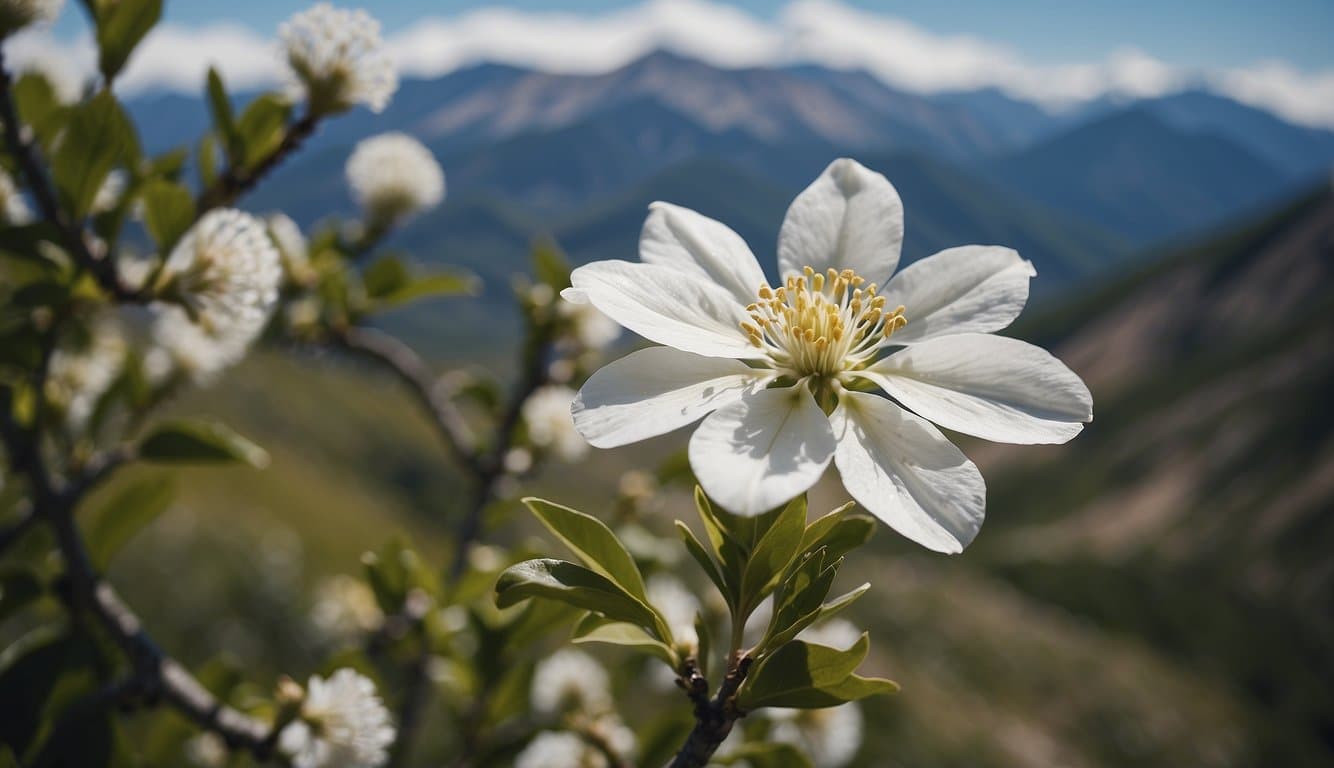
The state’s climate also welcomes other white flowering beauties that provide multi-season interest, like the Ornamental Pear. This tree captivates with its early white spring flowers, dense summer foliage, and a cascade of fall colors from bronze to bright red.
Whether it’s the Acoma crape myrtle, noted for its ease of care, or the fast-growing American elderberry, Colorado’s selection of white flowering trees offers homeowners and landscapers a variety of choices to enhance their outdoor spaces.
Key Takeaways
- Colorado’s climate supports a range of white flowering trees, including the drought-tolerant Russian Hawthorn.
- White flowering trees like the Ornamental Pear provide year-round aesthetic appeal.
- Landscapers value these trees for their versatility and ability to complement Colorado landscapes.
Classification and Types
In the diverse landscapes of Colorado, white flowering trees offer a stunning visual contrast against the rugged terrain.
This section explores the various species found in the region and their distinguishing features.
Species of White Flower Trees in Colorado
The state of Colorado is home to several species of trees known for their elegant white blooms. Some notable examples include:
- Acoma Crape Myrtle: Reaching up to 20 feet in height, this tree is appreciated for its vibrant summer flowers.
- Russian Hawthorn: A hardy species well-suited to Colorado’s varying climate, its drought resistance is a significant advantage.
- Ornamental Pear: Known for its three-season appeal, it showcases a profusion of white blossoms in early spring.
Each species has adapted to the local climate, offering beauty and resilience to Colorado gardens.
Identifying Characteristics
To identify these white flowering trees, one can examine:
- Blossoms: Characteristics of the flowers, such as size, shape, and blooming period, help in distinguishing between species.
- Foliage: The shape and texture of the leaves can provide clues to a tree’s identity.
- Growth Habit: The overall size and form of the tree are also indicative of its species.
With these identifiers, enthusiasts can appreciate the diversity and adaptability of Colorado’s white flowering trees.
Optimal Growing Conditions
The thriving beauty of white flowering trees in Colorado’s landscape hinges on the proper soil, sunlight, and watering conditions that meet their species-specific requirements.
Soil Requirements
White flowering trees in Colorado flourish in soils that provide good drainage and the appropriate nutrient balance. The soil pH levels typically favorable for these trees range from neutral to slightly acidic. Regular soil testing can guide amendments to keep conditions ideal.
- Drainage: Well-draining soil to prevent root rot
- pH Levels: Neutral to slightly acidic (6.0 to 7.0)
Sunlight and Watering Preferences
Sunlight and water are critical to the health of white flowering trees, with most species desiring full to partial sunlight for optimal bloom production.
Sunlight:
- Full sun (6+ hours of direct sunlight)
- Partial sun (4-6 hours of direct sunlight)
For Watering:
- Deep watering to encourage root growth
- Consistent moisture, but allowing soil to dry between watering to avoid over-saturation
Trees should be monitored for signs of distress and adjustments made to sunlight exposure and watering schedules as necessary.
Landscaping Uses
White flowering trees add a stunning visual interest to landscapes across Colorado, offering beauty and enhancing local biodiversity.
They play a significant role in creating themed gardens and carry a rich cultural importance in the region.
Design and Aesthetic Value
White flowering trees such as the Russian Hawthorn and the Acoma Crape Myrtle are treasured for their aesthetic appeal. These trees provide a striking contrast against Colorado’s verdant landscapes and rugged mountainous backdrop.
The Russian Hawthorn’s white blossoms and the Acoma Crape Myrtle’s summer blooms are central to many garden designs. They can serve as:
- Focal points in a landscape, drawing the eye during blooming seasons.
- Background plants for perennial beds, providing a calm and soothing backdrop for more colorful flowers.
- Natural screens, where their dense growth offers privacy and noise reduction.
Cultural Significance in Colorado
The use of white flowering trees in Colorado’s landscaping goes beyond mere ornamentation. These trees often have a cultural significance, reflective of the state’s heritage and the value residents place on natural beauty.
For instance, the Ornamental Pear, with its three-season display of white flowers, lush summer foliage, and vibrant fall colors, often adorns public spaces, celebrating the seasonal cycles so deeply rooted in Colorado’s outdoor lifestyle. These trees are frequently associated with:
- Historic landscapes where they complement Colorado’s architectural heritage.
- Community events and festivals, often blooming in coordination with local springtime celebrations.
Frequently Asked Questions
In this section, readers will find expert answers to common inquiries about the cultivation and types of white-flowering trees suitable for Colorado’s varied landscapes.
What species of trees with white flowers are native to the Colorado Front Range?
Native species such as the Russian Hawthorn and American Elderberry are excellent choices for the Colorado Front Range. These trees are adapted to local conditions and offer beautiful white blooms.
Which zones in Colorado are suitable for growing trees with white flowers?
Trees with white flowers can thrive in USDA Hardiness Zones ranging from 4 to 8. It’s important to select trees that are suited to Colorado’s high altitude and temperature variations.
Where can one purchase trees with white blossoms suitable for Colorado’s climate?
Local nurseries and garden centers often carry a selection of trees that are well-adapted to Colorado’s climate. For a diverse selection, one might also consider reputable online nurseries that ship to the state.
What are some of the tallest trees that bear white flowers in Colorado?
The Northern Catalpa is one of the tallest, reaching mature sizes of 50 to 70 feet tall. It serves well as a shade tree or a specimen tree in large Colorado landscapes.
What are the best white-flowering trees to plant in Colorado landscapes?
The Acoma crape myrtle tree is known for its low maintenance and drought tolerance, making it an ideal specimen for many Colorado landscapes. Additionally, its white blooms add stunning visual interest.
Are there any dwarf varieties of white-flowering trees that thrive in Colorado?
Dwarf varieties, such as certain cultivars of lilacs, can successfully grow in Colorado. These smaller trees offer extended bloom times and an appealing fragrance to gardens without requiring extensive space.
